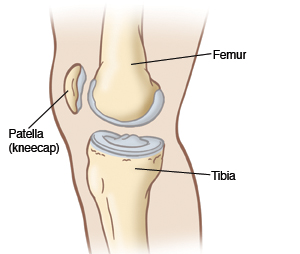Baker’s Cyst

You have a Baker’s cyst. This is a lump or bulge in the back of your knee. It's caused when extra joint fluid flows into a small sac behind the knee. The extra fluid collects here because arthritis or a torn cartilage irritates the knee joint.
A small Baker’s cyst often has no symptoms. A larger cyst can cause some knee pain or a feeling of pressure behind your knee when you try to fully straighten or bend that joint. A Baker’s cyst can leak, leading fluid to move down into your lower leg. This causes swelling, pain, and redness.
Treatment may involve draining the extra fluid. Or medicine may be injected to reduce redness and swelling. If the extra fluid is caused by a torn cartilage, then surgery to repair the cartilage may be the best treatment option. If arthritis is the cause, and it doesn't get better with treatment, surgery may need to address the arthritis and cyst.
Home care
-
If you have knee pain, stay off the affected leg as much as possible until the pain eases.
-
Apply an ice pack to the painful area for up to 20 minutes. Do this every 3 to 6 hours for the first 24 to 48 hours. Keep using ice packs 3 to 4 times a day for the next few days, as needed for pain. To make an ice pack, put ice cubes in a plastic bag that seals at the top. Wrap the bag in a clean, thin towel or cloth before using it. Never put ice or an ice pack directly on the skin.
-
If you were given a hook-and-loop knee brace, you may open the brace to apply ice. Unless told otherwise, you may also remove the brace to bathe and sleep.
-
You may use over-the-counter pain medicine, like acetaminophen or ibuprofen, to control pain unless another medicine was prescribed. Talk with your provider before using these medicines if you have chronic liver or kidney disease or have ever had a stomach ulcer or gastrointestinal bleeding.
-
If crutches or a walker have been advised, don’t put your full weight on your injured leg until you can do so without pain. Check with your provider before returning to sports or full work duties.
Follow-up care
Follow up with your healthcare provider in 1 to 2 weeks, or as advised.
If X-rays were taken, you'll be told of any new findings that may affect your care.
When to get medical advice
Call your healthcare provider right away if any of these take place:
-
Toes or foot become swollen, cold, blue, numb, or tingly
-
Pain or swelling increases
-
Warmth or redness appears over the knee
-
Redness, swelling, or pain starts in the calf or lower leg
-
Fever of 100.4°F (38°C) or higher, or as directed by your provider
-
Chills
Online Medical Reviewer:
Louise Cunningham RN BSN
Online Medical Reviewer:
Raymond Turley Jr PA-C
Online Medical Reviewer:
Thomas N Joseph MD
Date Last Reviewed:
2/1/2022
© 2000-2024 The StayWell Company, LLC. All rights reserved. This information is not intended as a substitute for professional medical care. Always follow your healthcare professional's instructions.